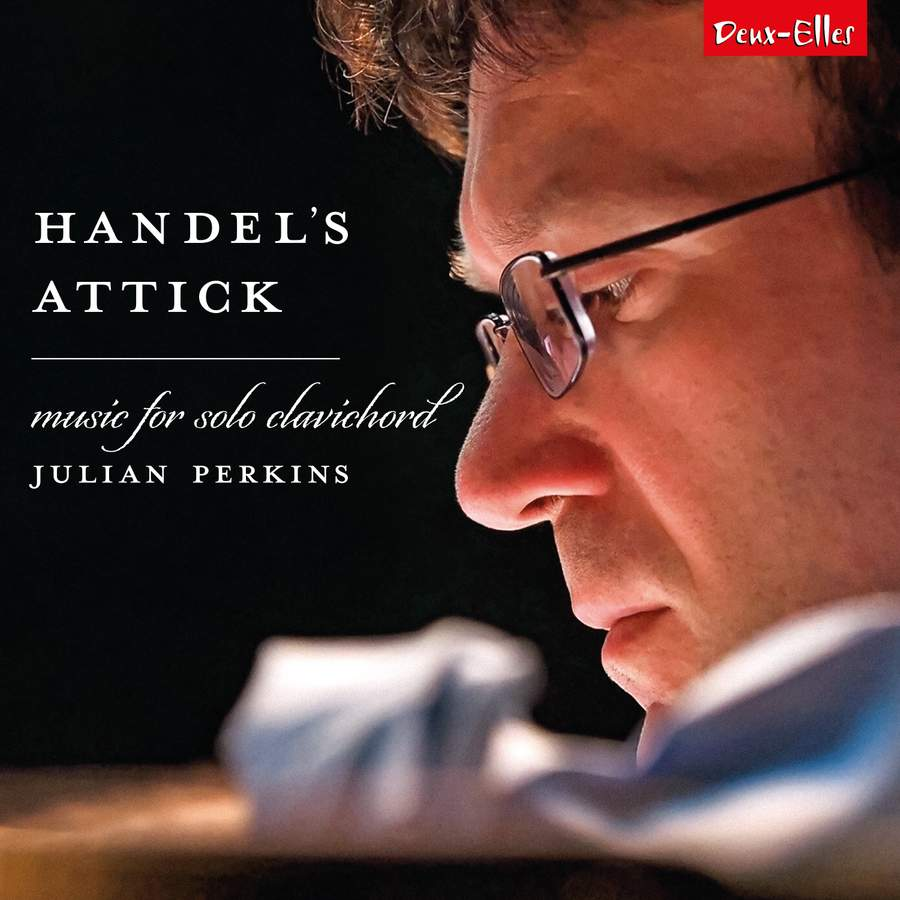Handel’s Attick: Music for Solo Clavichord
Julian Perkins, clavichords
Music by Arne, Ebner, Froberger, Handel, Kerll, D Scarlatti, Weckmann and Zachow
Deux-Elles DXL 1191. 75’33

This excellent recording from Julian Perkins is based on a story from Handel’s childhood, as told by John Mainwaring in his 1760 Memoirs of the Life of Handel. His father, suspicious of his musical interests, tried to stop him from playing any musical instruments at home. This led to Handel smuggling a tiny clavichord into the attic of their house so that he could practice at night, having “found means to get a little clavichord privately convey’d to a room at the top of the house“.
This recording is an excellent example of the beautifully refined sound of two clavichords, both modern copies by Peter Bavington of clavichords that Handel might have known. The first, used for the music that the young Handel might have played in his father’s attic, is a tiny fretted travel-clavichord, the second, larger instrument is used to demonstrate music that Handel might have played in his later life. This latter clavichord sounds very different from the tiny one heard earlier, with a less defined tone and a slightly more remote sound.
The music in the first half is from composers mentioned in a now-lost 1698 notebook that Handel used while studying with Zachow in Halle. It ends, appropriately, with a Suite by Zachow himself. The second part starts with music by the adult Handel, his Suite in G minor, HWV 452. Julian Perkins’ playing is exemplary in his well-chosen programme of musical contrasts. He is a thoughtful performer and plays with appropriate respect for the music and the instrument. Although both are essentially intimate, he manages to project the mood of the music well despite the intervention of the actual recording and listening process. He makes sensitive use of bebung, the technique of applying a gentle vibrato to individual notes by changing the pressure on the key while the tangent is in contact with the string.
For those not used to the clavichord, it is the most sensitive of all keyboard instruments, the action of the finger on the key raising a tangent to hit the strings directly with no intermediate bits and bobs of action to get in the way. It was an ideal practice instrument for organists of the day who needed to develop a similar sensitivity of touch when playing mechanical action organs.
If I may, I will digress for a personal recollection of the very first time I played a clavichord. It was during a major organ academy in Gothenburg where various keyboard courses were offered, including one for clavichord with Harald Vogel. During the afternoon of the academy, plenary sessions were held where the students of the various courses came together. During the clavichord plenary, all the clavichord students played and the offer was then made for anybody to come and have a go. After the inevitably very long silence, I eventually offered. As I walked up to the stage with its very distinguished group of organists, I decided the only thing to do was to play this strange instrument in the same way I would play a small historic organ. To my surprise, the response from the panel of experts afterwards was embarrassingly enthusiastic. It was clear that the same concept of weight distribution from the arms to the fingers which is key to playing historic organs, was also key to producing a clean sound from the clavichord. The response to anybody who does not have a well-controlled technique on the clavichord is pretty brutal – a responding clunk. I was then given a Bach Organ Trio Sonata to play on a two-manual and pedal clavichord, which I made a complete mess of, particularly in trying to play the clavichord pedals.
One question for listeners to this, or any other clavichord recording, is setting the volume correctly to reflect the instrument’s volume – it is a remarkably delicate sound. One way to ensure that you hear it as intended is to set your device to a “normal” music volume, for example using a harpsichord or orchestral piece. Then keep the same volume setting for the clavichord recording and resist the temptation to turn the volume up any further. Your ears will quickly get used to the subtlety of the sound of this most intimate of musical instruments.
If you are a clavichord lover or player, you will relish this recording. If not, do try it for an introduction to an instrument that was of major importance for most composers of the Baroque era and before.
